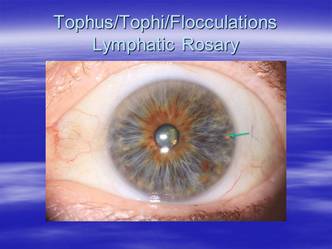
- Small white or cream-colored accumulations that look like cotton balls.
- Formations are caused by collagen bundles in the iris, so they are structural signs.
- Usually found in the sixth zone of the iris and may be in a few areas or all the way around the iris.
- One of these spots is called a tophus.
- Collective term for these accumulations is tophi.
- Many tophi are called flocculations or have also been called the lymphatic rosary.
- They look like a string of pearls, thus the name rosary.
- Tophi can also be found in the humoral or third zone of the iris.
- Indicate a potential genetic tendency for lymphatic congestion and stagnation.
- In a blue iris, the yellow rosary indicates a potential chronicity caused by yellowing over time.
- In a brown iris, the rosary may be colored with the brown pigment that is normal for that eye.
- The lymphatic rosary is a genetic sign.
- It is there at birth and does not go away.
- It may become more yellow during a person’s life, possibly caused by accumulated toxicity in the lymph system.


 RSS Feed
RSS Feed



